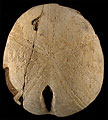The Echinoid Directory
Anthobrissus Pomel, 1883, p. 60
| Diagnostic Features |
|
|---|---|
| Distribution | Aptian to Lower Albian, Early Cretaceous of England and France. |
| Name gender | masculine |
| Type |
|
| Species Included |
|
| Classification and/or Status |
|
| Remarks |
|





